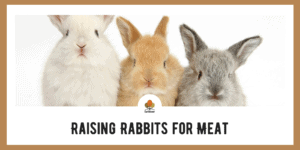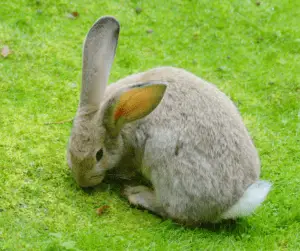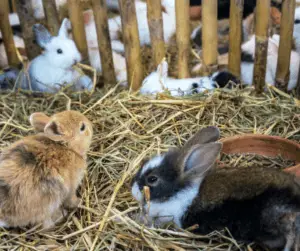When it comes to raising animals for meat, three kinds come to mind, cows, pigs, and chickens.

Cow and pigs are obvious choices because they are large and one of them provides a lot of meat.
Chickens are easy to raise and other than meat, they also provide a renewable source of food in the form of eggs.
But one animal that is often overlooked is the rabbit. And there are several great reasons to raise rabbits for food.
Why Raise Rabbits?
Affordable
Raising larger livestock like cows or pigs can be expensive. They require land and more resources such as fences, barns, buildings, food, and water.
Rabbits do require much of the above but on a smaller scale. The cost per rabbit to begin raising them is also far less than purchasing larger livestock.
Location
Rabbits are usually raised in small pens or hutches, rather than a larger fenced-in pen or pasture.
This allows rabbits to be raised in both rural and urban environments.
However, it should be noted that many urban locales have strict laws regarding the type of animal a homeowner has on their property.
This is especially true as it related to raising animals as a source of food.
Be sure to research your local laws and regulations on this subject before becoming invested in it.
Not Picky Eaters
Rabbits will do better eating certain foods over others. But you can give them certain types of fruit or vegetable scraps from the kitchen in limited amounts, or you can even let them graze in your yard.
However, a rabbit’s diet primarily consists of grass, hay, pellets and other leafy greens.
Rabbits Everywhere!
We all know the old saying of how rabbits breed, and this is one of the main benefits of raising them.
I will discuss this in more detail in a later section but when starting with just three to four adult rabbits there is a potential of rearing almost one hundred offspring within a year!
Sell Them
There are several ways to sell rabbits.
- The harvested meat can be sold.
- The fur can be sold.
- Live rabbits can be sold to other people for breeding and meat purposes.
- And lastly, because rabbits are so docile, they make pretty darn good pets.
Healthy Meat
Rabbit is a healthy meat option because it is so lean, meaning it has a very low content of fat.
In fact, their fat content is so low there such a thing as “rabbit starvation.” This refers to a person whose diet consists of only lean meat without another source of fat and nutrients. This causes protein poisoning and can lead to death.
Fur
Animal fur is not as widely sought after as it used to be, but there are still those that will seek it out and pay for it.
Rabbit fur is incredibly soft and warm, making it the ideal material for certain garments.
Choosing A Rabbit
There are many different types of rabbits to choose from but here is a list of a few of the most popular ones to raise for meat.
New Zealand White
This is one of the most popular rabbits to raise and they can weigh up to twelve pounds.
American Chinchilla
Chinchillas are often used in cooking both at home and in restaurants that serve this type of meat. These rabbits can weigh around nine pounds.
Flemish Giant
This choice of rabbit will require more resources than your typical rabbit. They have a hearty appetite and will need more space because as their name suggests they are quite large. Flemish Giants routinely weigh in around twenty pounds!
Breeding
Part of the reason so many litters can be had in such a short time is that most female rabbits are fertile year-round. Not only that, but they can become fertile again very quickly after birthing a litter.
However, just like many other animals, the process of carrying young and birthing them is hard on the body.
For this reason, it is a good idea to space out the breeding timeframe accordingly which will be dependent on the type of rabbit you choose.
This is also why male rabbits will have to be separated from females once the female has become pregnant.
Pens, Hutches, and Free Range
Rabbits will need to be kept in a secure enclosure. This is not only to keep them from running away but to protect them from predators.
Pens or hutches can be bought commercially but they may run you several hundred dollars.
A person with a few basic tools and some handyman experience can drastically reduce that cost by building an enclosure themselves.
A very simple pen can be constructed using some hardware, wood, and chicken wire.
To make cleaning the enclosure easier, the bottom should be made from wire so that a removable waste tray can be placed beneath.
Keep Them Protected
Special consideration needs to be given to the predators that live in your area and the security of the rabbit’s enclosure.
Chicken wire is sufficient for keeping a rabbit contained but not for keeping all predators out. Large predators could simply break through this material.
While gruesome to think about, smaller predators will reach in through the gaps of a hutch and pull pieces of the rabbit out.
Temperature Control
Some rabbits are quite hearty when coping with temperature extremes. However, this depends on the type of rabbit and if they are in their native habitat.
Bringing a rabbit into a non-native area means they may need special accommodations to deal with environmental factors.
When it is cold, plenty of bedding should be available to help keep the rabbits warm and insulated. Of course, they could be housed in heated buildings, but this will certainly raise the cost of operations.
During hotter parts of the years, the rabbits will need to be housed in areas where shade is available. Fans could also be utilized to promote air circulation and help keep them cool.
Free Range
Another option is to raise rabbits in a more “free-range” style.
This involves choosing an area on the property to fence the rabbits in. But this is not as simple as it sounds.
This will require more time and money to ensure protection from predation since the rabbits will be housed in a larger area outside.
You will not only need to provide walls, but you will need to provide protection from both below and above.
Some predators will attempt to dig under the wall while birds of prey will attack from above.
Lastly, raising rabbits in this manner should only be done in areas that have not been exposed to chemical treatments. Herbicides and pesticides can make rabbits sick or taint the meat.
Water and Food Setup
Like all animals, whether they be pets or livestock, rabbits will need a constant source of clean water.
Simply placing a bowl of water in the enclosure is not a good idea unless you plan on replacing the water a lot. This is because a bowl may get knocked over or become contaminated with fecal matter and urine.
A better option is to purchase a water bottle that can be attached directly to the frame of the pen. This will help to keep the water clean and will not need to be refilled nearly as often.
A similar approach to food should be taken. A self-contained container or self-feeder will help the food from becoming contaminated.
Processing Station
Once the rabbits have reached their desired size, they will need to be harvested.
This can be done in a kitchen and part of it will be. But the initial process is messy and is best done outdoors or in an outdoor building.
A workstation or table of some sort to work on makes this task more comfortable, especially when processing multiple rabbits. It is also helpful if the workstation surface can be easily washed off.
A small sharp knife helps with the beginning cuts into the fur and cavity while a larger chopping knife easily removes the limbs and the head.
You will also need a container or method for dealing with waste such as the entrails, fur, and blood.
Ideally, this work area will be located near a water source so that the rabbit cavity, tools, and workstation can easily be cleaned up afterwards.
Rabbit Recipes: Top 3 Picks
I grew up hunting a lot and one of my favorite animals to bring home were rabbits. At times they could be tricky to hunt down but once they were in hand, they were incredibly easy to process and turn into a meal.
I have always enjoyed eating rabbit meat and I wanted to share a few of my favorite recipes that are quick, easy, and tasty.
Fried Rabbit
What you will need:
- Crackers
- A plastic resealable bag
- Rolling pin
- A few eggs
- Vegetable or olive oil
- Seasoning
- Rabbit meat
This was one of the main ways in which a rabbit was cooked in my house and it tastes really good.
The first step is to crush up a bunch of crackers into a fine powder. This works best by placing the crackers into a plastic bag and using a rolling pin to grind them into a powder.
Also, add in whatever season you like such as salt and pepper.
Then cut up the rabbit meat into the sizes you want or leave it on the bone when it comes to the legs.
Next, scramble a few eggs in a bowl and place the meat inside, allowing all the meat to be covered by the egg
Now, quickly transfer the meat to the bag of crushed up crackers and shake. Ensure that the meat is completely covered in cracker crumbs.
The last step is to fry it up in a pan of hot oil. The result is a piece of golden brown rabbit meat that rivals fried chicken.
Rabbit Stew
What you will need:
- Large pot or crockpot
- Water
- Rabbit meat
- Preferred stew vegetables
- Seasoning
This recipe takes the longest to cook but is easy to set up.
I prefer using a crockpot due to its simplicity.
I begin by putting several cups of water into the crockpot and setting the temperature to high.
I then cut up all the vegetables I like to put into the stew. This includes potatoes, onions, a little bit of garlic, and carrots.
Once the crockpot is warmed up I like to put the entire rabbit into the crockpot. This will help to add flavor and less meat will be wasted.
I will then add in my vegetables and more water. Usually, I bring the water level to the top of all my ingredients.
Lastly, add in any seasoning that you like. Generally, I add just a little salt and pepper.
I love using crockpots because you can set it and forget. I have made this stew by setting the temperature to medium and letting it cook overnight, or by cooking it on high heat for several hours.
When it is done, the meat will have fallen off the bone and will melt in your mouth.
Fire Roasted Rabbit
What you will need:
- A firepit
- A spit
- Time
If you want to go ultra-simple and all-natural, rabbit cooked over an open flame is also quite delicious.
Out of the three recipes, this one is the most straightforward but will require your attention.
A commercial spit can be used but rigging one up using a few sticks is pretty easy.
One piece of advice when using sticks is to place the two sticks through the rabbit at slightly different angles to one another.
This way the entire rabbit can be turned during cooking. When a single stick is used the rabbit tends to not move as the spit is rotated.
Slowing rotate the rabbit above the fire to ensure that all of it is cooked evenly.
Once the outside is browned you may need to cut into it to check its doneness. Avoid leaving any undercooked meat that will show up as red or pink.
This way of cooking a rabbit may sound bland to some but you would be surprised at the flavor smoke and fire bring to the table.
Pros and Cons of Raising Rabbits
Pros
- Affordable
- Extremely fast reproductive rates
- A lean source of meat
- Easy to care for
- Requires less space over other livestock
- They can be raised in some urban areas
- Low startup cost
- Can be sold for meat, fur, or as pets
Cons
- May require special permits to raise or sell
- Need to be protected from predators
- More offspring more often requires will require more attention
Wrap Up
Anyone desiring to have their own source of meat should seriously consider raising rabbits.
There is a relatively low startup cost, they are easy to care for, they produce a lot of offspring, and the turnaround time from conception to processing is quick.
All of this makes raising rabbits for meat a particularly good option.
Thanks for reading!
What are your thoughts on raising rabbits? Sound off in the comment section below and let us know!


